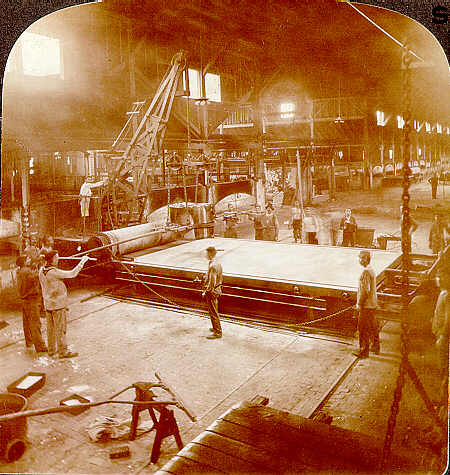Your Guide to the
Alle-Kiski Valley
and the Greater
Pittsburgh Area
Saturday
August 23, 2025
Home
Go Outside
History
Diversion
Back Issues
|
History - Industry - PPG Tarentum
|
Casting and Rolling
Sheets of Plate Glass

Here we see one of the most interesting processes in the manufacture of glass. That huge
clay pot, poised above the casting-table, has just come from the furnace and contains
the fluid glass. The man on the platform of the electric cranes will release the levers
in such a way that the pot will be tapped to allow the glass to fall upon the mold.
That roller at the further end of the casting-table is then passed rapidly over the
mold to reduce the glass to a uniform thickness.
The mold will then go through a
series of furnaces called a "lehr." This "lehr" is generally about 200 feet long
and consists essentially of a continuous, covered, smooth, level bed of specially
prepared clay, which, beginning at the first furnace, heated to about the melting
point of glass, passes through five "stations," or furnaces, each in succession,
having a somewhat lower temperature.
The mold after resting in the first, or hottest
furnace, for a sufficient period, is slowly moved along through the four succeeding
stations, gradually losing its heat until the red "lehr" is reached, when it is
withdrawn. This entire process consumes only three hours, while in former days by
the old method it took three days. When it leaves the "lehr," the plate is thoroughly
set and ready to be taken off, ground and polished.
Next - Revolving Iron Disks
Grinding Surface
of Plate Glass
Previous - Drawing a Pot of Liquid
Glass from the Furnace
Return - PPG Tarentum
|
|